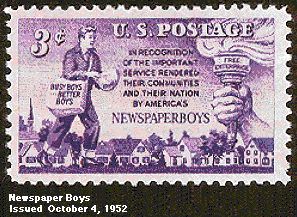| Mass Communication Media on Stamps Newspapers |
|
|---|---|
 Newspapers have been called the first communications medium for mass society.
Newspapers have been called the first communications medium for mass society.
Newspapers started in the 16th and 17th centuries. In Venice a news sheet carrying news available to the public cost a gazetta, or small coin, in the mid-1500s. A modern newspaper is defined as: published at least weekly; produced by mechanical printing process; available to ordinary people; prints news of general interest; readable by people of ordinary literacy; is timely; and is stable over time. The first to meet this criteria was the Oxford Gazette, later the London Gazette published in 1665 under authority of the Crown The concept of freedom of the press originated in England and America in the 16th and 17th centuries. The mutual distrust between government and media dates to the first American newspaper in 1690 - a three-page publication called Publick Occurrences, Both Foreign and Domestick. It was published in Boston by Benjamin Harris and was critical of the Crown. Under British law, the government had the right to approve content. The paper was suppressed by the government after just one issue. The first newspaper published continuously was the Boston News-Letter in 1704. The New York Weekly Journal was published in 1733 by printer John Peter Zenger, competing with the officially authorized The New York Gazette. By 1775, the population of the colonies was 2.5 million people and they were served by 48 small weekly newspapers. By 1800, there were 20 daily papers and more than 1,000 small town and frontier weeklies. Newspapers in the first half of the 19th century were more involved in the political process than today's papers, filled with political and business news. By the 1830s steam-powered rotary presses made it possible to print 20 times the sheets of paper per hour. The first of the mass circulation dailies, aimed at the common man, was the New York Sun published by Benjamin Day in 1833. It sold for one cent and became known as the penny press. Its crime stories and soft features made a dramatic change in newspaper coverage. By 1900, the number of dailies had jumped to 2,226. Newspapers had settled into the format we're familiar with today – different sections, domestic news, foreign news, etc. The Golden Age of newspapers, in number of subscribers, was at the beginning of the 20th century, from about 1910 to 1930. At that time many subscribed to both a morning and afternoon paper. After 1930, newpaper subscriptions declined because of competition from other media – radio, magazines, television. Since 1910 there's also been a steady decline in the number of daily newspapers published. Some merged, some became weeklies, some died. In 1992, there were 1,570 daily newspapers publishing in the U.S. – including 994 afternoon and 596 morning. By 1993, 1,556.  In the late 19th century, there was great competition between newspapers, but no competition from other media.
In the late 19th century, there was great competition between newspapers, but no competition from other media.
The circulation competition led to the period we know as yellow journalism, named after the Yellow Kid comic strip. Joseph Pulitzer and his New York World went head to head with William Randolph Hearst and his New York Journal. Coverage centered on sensationalism rather than responsible reporting. By the end of the century, yellow journalism died out and reporting became more responsible. By 1900, newspapers had settled into the format we're familiar with today – different sections, domestic news, foreign news, etc. However, some wonder if yellow journalism has returned in the 1990s. |
|
American Philatelic Society member SpaceToday.org.

| Navigating this Virtual Stamp Album | |
|---|---|
| | TOP OF THIS PAGE | | PRINTING | BOOKS | NEWSPAPERS | PAMPHLETS | MAGAZINES | | TELEGRAPH | WIRELESS | RADIO | TELEVISION | | MOVIES | RECORDINGS | THE WORLD WIDE WEB | | STAMP ALBUM FRONT PAGE | |  To the Webmaster's page |